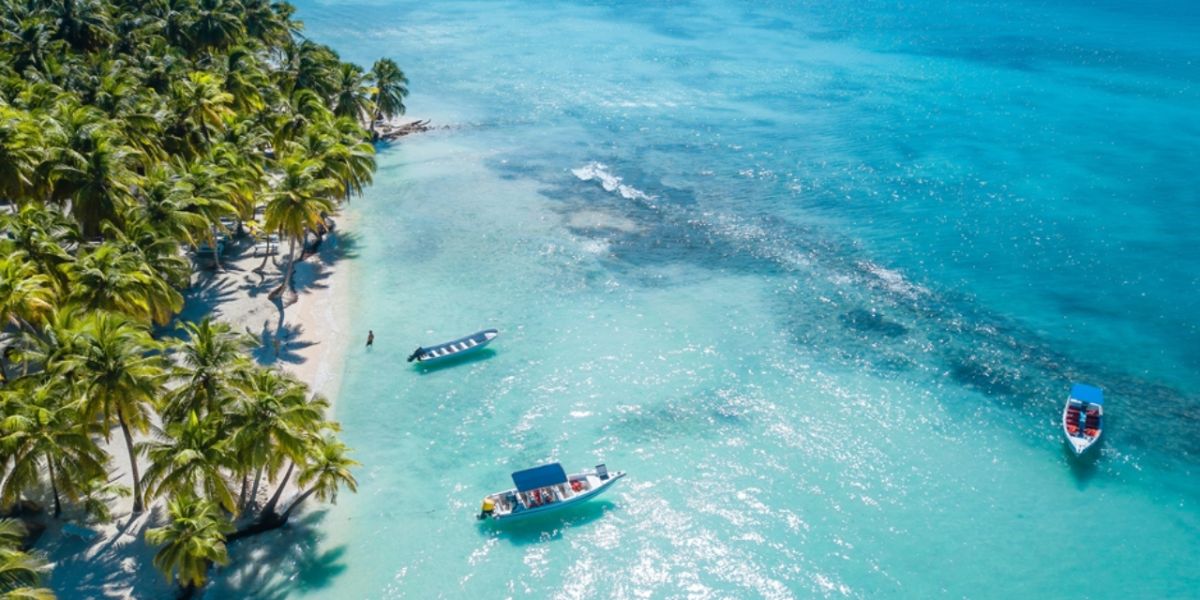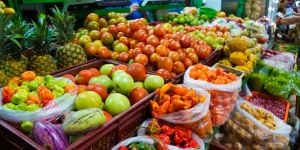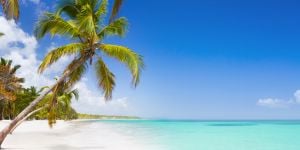
The Dominican Republic is situated in the northern part of the Caribbean. It is part of an island called Hispaniola, which was discovered by Christopher Columbus back in 1492 and used as his springboard for the Spanish conquest of the Caribbean. In fact, his very first landfall in the whole of the Americas was on the northern coastline of the Dominican Republic (DR). The DR takes up roughly two-thirds of the eastern part of Hispaniola, with the Western third being Haiti. The country's area is 48,730 km², around twice the size of Wales, making it the second largest country in the Caribbean after Cuba. The Northern coast borders the Atlantic Ocean, and the South borders the Caribbean. The capital, Santo Domingo, is situated in the middle of the Southern coast.
Although Hispaniola is one island, the two countries sharing the island, the Dominican Republic and Haiti, are completely different in terms of culture, language, and people.
Geography of the Dominican Republic
The Dominican Republic is not a typical tropical Caribbean island as its very size means that it consists of much more than just beaches, even though there are over 1600 kilometers of coastline with some of the most beautiful beaches in the world. However, the interior of the country is very diverse, with mountain ranges, fertile plains, rainforests, and even deserts. The highest mountain range in the Dominican Republic, and indeed, in the whole of the Caribbean, is the Cordillera Central, which has the four highest peaks in the Caribbean, the highest of which is Pico Duarte (3,098 meters/10,164 feet). The center of the country has fertile valleys, especially the Cibao region, which is the hub of the country's agriculture, consisting particularly of rice, bananas, coffee, and cocoa.
In addition, there is a strong emphasis on preserving the environment, and there are scientific reserves and national parks to protect some of its amazing flora and fauna.
While there are beautiful beaches and stunning countryside, there are also several major cities, each with its own attractions. The capital, Santo Domingo, is home to around 3 million people and has everything that a major city can offer in terms of shopping, culture, and business opportunities. It is not only a vibrant modern city but also home to what is known as the Colonial Zone, which is the old part of Santo Domingo, many parts of which have been kept exactly as they were when Christopher Columbus moved there. Walking through the cobbled streets with colonial homes lining them is like traveling back in time. The second largest city, Santiago de los Caballeros, is situated in the central northwest of the country, nestled between two of the major mountain ranges, and has a population of around one million people.
Population of the Dominican Republic
The total population of the Dominican Republic is around 10 million. Prior to Columbus' arrival, the local population consisted of Taino Indians. Columbus encouraged Spaniards to move to the country, and in addition, a relatively small number of slaves arrived from Africa to work in the sugar cane fields, although nothing like the numbers that went to Haiti and a few other Caribbean islands. As a result, the vast majority (about 80%) of Dominicans are mostly of brown skin tone, coming from a combination of the Taino Indians, African slaves, and Spanish colonists, while the rest are of African descent and others of pure Spanish descent and therefore more Caucasian-looking. In addition, as the sugar cane market increased, many freed English-speaking African slaves from other Caribbean islands came to work on the sugar cane plantations in the country and were known as Cocolos.
In addition, there are small enclaves of descendants of people from other countries, such as freed black slaves in Samana in the northeast peninsula, who arrived from the United States a century or so ago; a colony of Japanese people in the mountains in Constanza in the middle of the country; and Jews who were invited by the then President Trujillo after the Second World War, who settled in Sosúa, now a tourist area in the North of the country.
Economy and government of the Dominican Republic
The Dominican Republic is a representative democracy. There is a president voted in for four years at a time, along with the vice president. The president appoints his cabinet, and there are then 32 members of the Senate and 178 members of the Chamber of Deputies. In addition, there are mayors for each local council throughout the country.
Elections are held every four years, and there is one main party, the PLD, Partido de la Liberación Dominicana (Dominican Freedom Party), which has been in power for several years. There are then two smaller parties, the PRD, Partido de la Revolución Dominicana (Dominican Revolutionary Party), and the PRM, Partido Revolucionario Moderno (Modern Revolutionary Party), along with a host of even smaller parties.
As far as the economy of the country is concerned, the Dominican Republic is constantly the best-performing economy in the region. It is also the ninth-largest economy in Latin America. The economy is diverse and relies primarily on tourism, agriculture, and mining, but it also has a fast-developing service economy with many call centers on the island and Free Trade Zones used primarily for manufacturing shoes, tools, clothes, and jewelry for the US market.
Agriculture, although less than before in terms of percentage of GDP, is also a major part of the economy, exporting bananas, coffee, cocoa, avocados, mangoes, along with a range of other fruits and vegetables. The once-booming sugar industry is nowhere near as important as before, although when traveling through the country, several sugar cane plantations can be seen, mainly used in the manufacture of rum.
However, one of the most important aspects of the Dominican economy is that whatever the growth figures show, the Dominican Republic is still one of the poorest countries in the Caribbean as the wealth is skewed towards the small percentage of the affluent, who are mostly the descendants of Spanish settlers. Over 40% of Dominicans are still deemed to be living in poverty, with another 40% only just over the poverty level, making the Dominican Republic more of a developing country rather than a glitzy Caribbean island.
Climate in the Dominican Republic
Located between the Tropic of Cancer and the Equator, the Dominican Republic has a tropical climate, with the average temperature being 25°C (77°F). In the mountains, it is significantly cooler, averaging 18°C (64.4°F). It is almost always sunny and warm, although, as with all tropical climates, there is a rainy season. Along the Northern coast, the rainy season lasts from May to January of the next year, whereas elsewhere, the wet season mainly lasts from May through November. Average annual rainfall is around 60 inches, although it varies throughout the country, with more rain in the Northeast and less in the West and the Southwest.
The typical weather is a blue sky with some clouds and a light breeze. If there is rain, it is more likely in the afternoon and at night. When it does rain, it normally results in a tropical downpour and the occasional thunderstorms. Humidity is a problem in the summer, and, combined with the high temperatures, it can become uncomfortable, particularly in July and August.
The Dominican Republic is affected by the Atlantic hurricane season, which lasts from June to the end of November, although it is most likely to affect the country between August and October. Hurricanes do strike the country almost every year, with 65% of the impacts being along the Southern coast. However, they mostly arrive as tropical storms or Category One hurricanes. The last time a Category 5 hurricane struck the country as a direct hit was Hurricane David in 1979, and Hurricane George struck as a Category 4 in 1996, although in 2017, Hurricanes Irma and Maria skirted the North coast as Categories 5 and 3 respectively.
The Dominican Republic also experiences earthquakes. There is seismic activity almost daily, but earthquakes are so minor that they usually cannot be felt. There are two major fault systems which run through the island. One is the North Hispaniola Trench, and the other is the Septentrional Fault Zone, which has been responsible for most of the earthquakes in the Dominican Republic's history, including the major earthquake that hit Haiti on 12th January 2010.
Expatriates in the Dominican Republic
The Dominican Republic is home to thousands of expatriates, some who work and some who are retired. Many nations are represented, with the majority being from the USA, Canada, Italy, Germany, France, and the UK. In recent years, the number of South Americans, especially Columbians and Venezuelans, has increased, as has the number of Russians. Most expatriates live in the two main cities, Santo Domingo and Santiago, as well as the tourist areas of Puerto Plata, Sosúa, and Cabarete along the North coast, Samaná and Las Terrenas in the Northeast, Punta Cana and Bávaro in the East, and La Romana and Juan Dolio along the South coast.
Useful link:
Dominican Republic Ministry of Tourism
Quick information:
Official languages: Spanish and Castilian
Currency: Peso
Area: 48730 km²
Population: 11,117,873
Calling codes: ++1-809 and 829
Timezone: Atlantic Standard Time (AST)
We do our best to provide accurate and up to date information. However, if you have noticed any inaccuracies in this article, please let us know in the comments section below.








